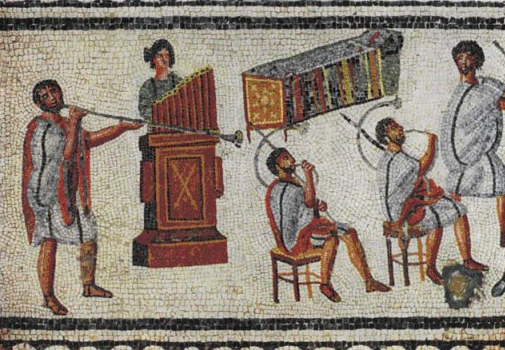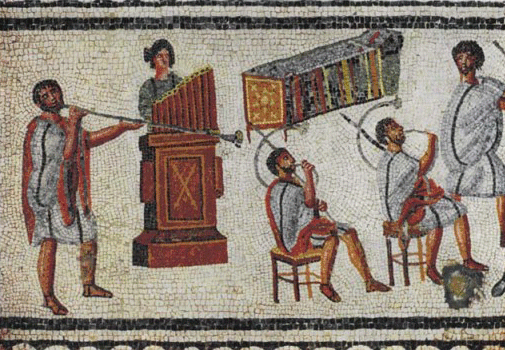Arts & Culture: A Blast from the Past
The Roman emperors could command their people’s attention with a sonic blast from a three-meter-long horn, called a cornu. Historians believe that this metallic instrument, which was curved in the shape of a letter “G,” produced a powerful audio signal that could convey messages long distances to both citizens and soldiers. Until recently, however, this signature sound of ancient Rome seemed consigned to oblivion, as all the remaining cornua from this time are broken, unplayable relics. But thanks to a new acoustics study, scientists have created a virtual reconstruction of this instrument, which allows a two-thousand-year-old past to be heard again.
The ancient Romans had a gamut of instruments: from the oboe-like tibia, to the multistringed lyra and the water-based organ hydraulus. “Music was everywhere,” explains Roman historian Alexandre Vincent from the University of Poitiers, France. “Romans played music for theater performances, religious ceremonies, and private banquets.”
In this musical milieu, the cornu was unique in having a role both in communication and entertainment. “The cornua were very useful for how the ancient city worked,” Vincent says. A call from the cornu summoned the population for a decree or the start of a gladiator game. The instrument was also important for the Roman army, as it provided signals to soldiers on the battlefield. “It was a sound of power,” Vincent says.
We know of the cornu partly from the many works of ancient art that depict it. Murals and carved reliefs show cornua being played in battle scenes and for burial ceremonies, as well as at gladiator games, where they apparently were accompanied by other instruments, like the hydraulus organ and the long, straight tuba horn. Historians have also found references to the cornu in ancient texts, in which the sound is often described as being raucus (harsh) and trux (savage).
Archaeologists have discovered several relics of ancient cornua, with those found in the ruins of Pompeii in Italy being among the best preserved. Based on early studies of these archaeological finds, several 19th-century instrument-makers created replica cornua that can still be played to this day. But it’s not clear that these copies offer an accurate audio representation of the original cornua, which is why Vincent and his colleagues decided to perform a re-analysis—with modern equipment and techniques—of the five relic instruments from Pompeii, housed in the National Archaeological Museum in Naples, Italy. “Our goal was to understand the manufacturing methods and the acoustics of [these] cornua,” says the project leader Christophe Vendries from the University of Rennes, France.
Part of this cornu study involved measuring the instruments’ composition. Benoît Mille, an archaeometallurgist from the Center for Research and Restoration of the Museums of France, analyzed several samples and found that the five cornua consisted of the same bronze alloy, suggesting that they were all made at the same workshop. The Roman instrument-makers shaped the metal into very thin sheets, producing horns that weighed roughly a kilogram—four times lighter than the replicas made nearly two millennia later.
For their acoustic analysis of the Pompeii cornua, René Caussé and his team from the Institute for Research and Coordination in Acoustics and Music (IRCAM) in Paris began by measuring the dimensions of the instruments—a task made difficult by the fragmented state of the relics. They determined the average length of the cornua to be 3.4 m and estimated how the internal profile widened from one end to the other, like a cone. These measurements were entered into Modalys, a software tool that the IRCAM team had previously developed for designing new instruments. “[The software] allows a musician to explore the sounds that can be produced if you change what an instrument is made of or where things like holes are placed,” Caussé explains. For this project, he and his colleagues used Modalys to create a virtual cornu.
Within the computer program, the team could simulate different lip positions and blowing methods that Roman cornu players may have used. They identified several frequencies that would have resonated in the instruments, but many of these notes were not in harmony with each other. The team did find one harmonic series, but it only consisted of six notes. “The instrument probably wasn’t very good for playing melodies,” Caussé says. But it was loud. The researchers estimated that the cornu’s sound level at a distance of 5 m was between 90 and 100 dB.
The closest modern instrument in both loudness and pitch to the cornu is probably the flugelhorn, Caussé says. However, compared to cornua, flugelhorns and other modern brass instruments have a wider opening, or “bell,” allowing them to produce many more notes belonging to the same harmonic series.
With their simulated cornu, the IRCAM team created two musical pieces for the 2017 exhibition “Music! Echoes of Antiquity” at the Louvre-Lens museum in northern France (see videos). The first was a traditional military call, and the second was a portion from Gustav Mahler’s second symphony. A book entitled Cornua de Pompéi was published in January, detailing the whole project.
Despite the instrument’s limited notes, Vincent thinks a well-trained cornu player could have produced a wide range of music. “The simulated sounds confirm the historical depictions of cornua being played with other instruments,” he says. Vincent hopes to eventually study the acoustics of other brass horns, as well as metallic gongs, from ancient Rome. With computer simulations of these instruments, scientists might one day put on a virtual concert that a Roman emperor could have enjoyed.
–Michael Schirber
Michael Schirber is a Corresponding Editor for Physics based in Lyon, France.





